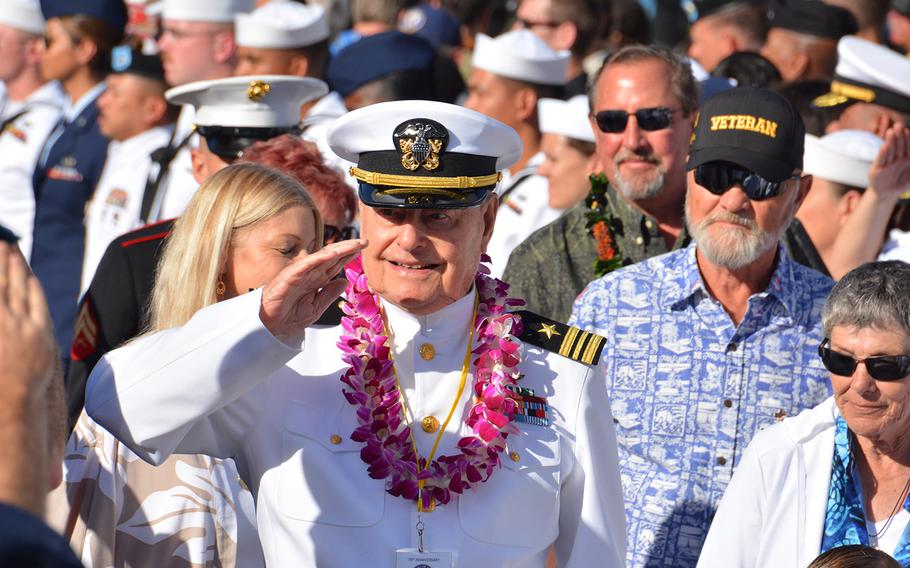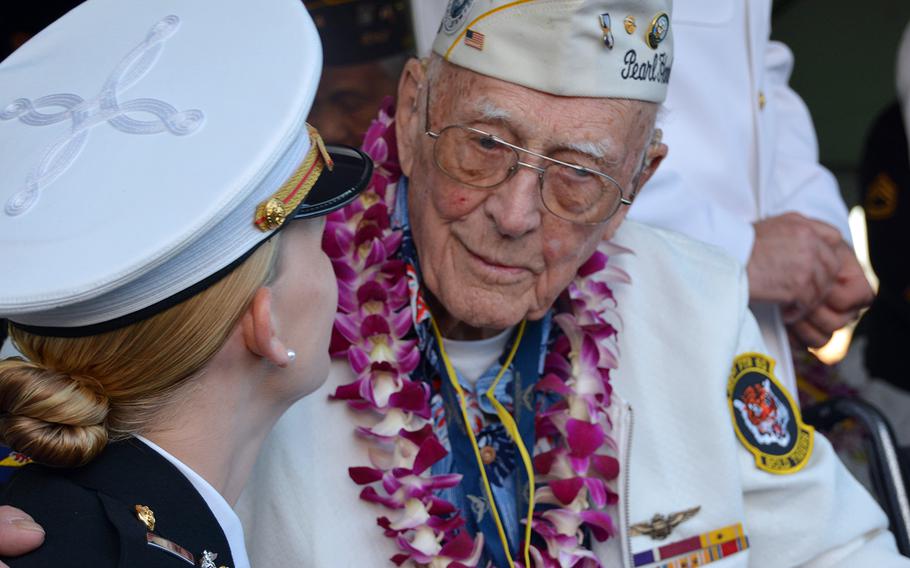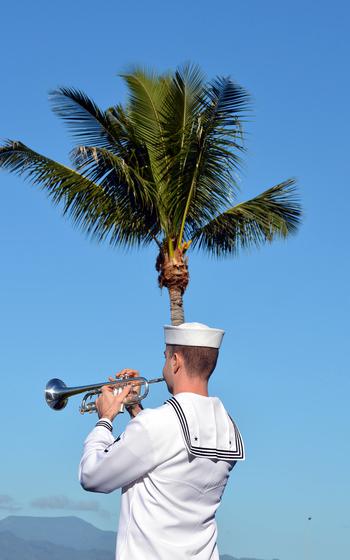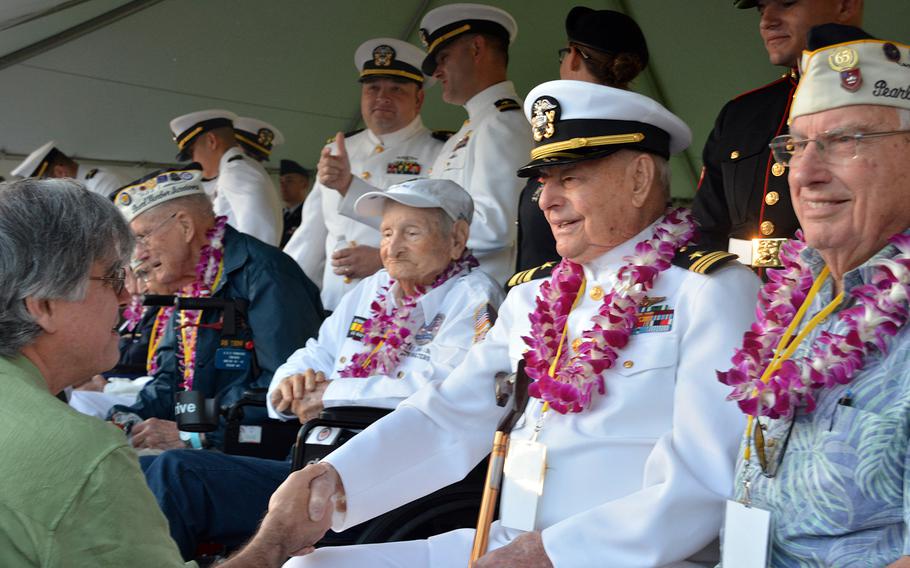
Lou Conter, 98, one of only three living survivors USS Arizona survivors, salutes during the Walk of Honor after a Dec. 7, 2019, ceremony at the Pearl Harbor National Memorial marking the surprise attack 78 years ago. (Wyatt Olson/Stars and Stripes)
PEARL HARBOR NATIONAL MEMORIAL, Hawaii — An ever-thinning number of veterans who survived the attack on Oahu by the Japanese on Dec. 7, 1941, attended Saturday’s ceremony here marking the 78th anniversary of the event that led America to enter World War II.
The veterans occupy a rarified position in our nation, but in past years they sat among the audience of hundreds who flock to the early-morning observance.
This year, the roughly dozen survivors attending were so few they were seated on a raised platform in front of the audience, becoming more the objects of high esteem than observers.
“As each year passes, we lose more of our friends who served here on Dec. 7, 1941, or who witnessed the attack,” Jacqueline Ashwell, superintendent of the Pearl Harbor National Memorial, said during the ceremony, craning her neck to gaze at the aged veterans seated behind the speaker’s podium, all in their 90s or older and many in wheelchairs.
Among them was Lou Conter, the only survivor of the USS Arizona to attend. The remaining two Arizona survivors, Donald Stratton and Ken Potts, are no longer able to travel to Hawaii for the annual event.

Don Long, who was stationed at Kaneohe Naval Air Station during the Japanese surprise attack, chats with a guest Dec. 7, 2019, at the Pearl Harbor National Memorial before a ceremony marking the attacks' 78th anniversary. (Wyatt Olson/Stars and Stripes)
“I talked to Don Stratton just a couple weeks ago before I came out here,” Conter said shortly before the ceremony began. “Ken’s in bed and we couldn’t even get hold of him to talk to him.”
Two Arizona survivors, Lonnie Cook and Lauren Bruner, died this year.
On Saturday evening, Bruner’s remains were slated to be entombed in the hulk of the battleship, which sank to the bottom of Pearl Harbor during the attack. It serves as a tomb for the hundreds of crew members who went down with the ship.
Bruner’s will be the last remains to be encased in the ship, a place of honor reserved only for survivors of the ship’s sinking, which killed 1,177 of the sailors and Marines aboard. The other three survivors have said they will not have their ashes placed in the ship.
Japanese torpedo bombers and fighter planes attacked sailors, Marines and soldiers wherever they were stationed on Oahu on that momentous Sunday morning.

A sailor plays taps Dec. 7, 2019, to honor those who lost their lives during the Japanese surprise attack at Pearl Harbor 78 years ago. (Wyatt Olson/Stars and Stripes)
“The horrific events that occurred here caught America, her Navy, her Army, her Air Corps, her Marines and the territory of Hawaii by surprise,” Harry Harris, U.S. ambassador to South Korea, said during a speech. “It fell upon the shoulders of the Pearl Harbor survivors and World War II veterans behind me to respond on that fateful day.
“In less than two hours, there were over 2,400 killed, including firemen and first responders from the Honolulu Fire Department. Almost 1,200 wounded. The majority of the U.S. Pacific Fleet, taken out of action. Catastrophic by any standard.”
Stuart Hedley, 98, who was serving on the battleship USS West Virginia, said he saw his skipper, Capt. Mervyn Bennion, disemboweled and killed by shrapnel that bounced off the nearby USS Tennessee.
The West Virginia took at least nine torpedoes, and as it began to sink, sailors made for the Tennessee any way they could.
“Five of our buddies overhanding on a rope to the Tennessee got machine-gunned by Japanese [Zero fighters],” Hedley said. So instead of going by rope, he and a group of other sailors climbed onto the barrel of the West Virginia’s 5-inch gun, ran the length of it and jumped onto the Tennessee, he said.

Lou Conter, shaking hands, sits with other veteran survivors of the Japanese surprise attack on Oahu before the beginning of a ceremony Dec. 7, 2019, at the Pearl Harbor National Memorial that marked the event. (Wyatt Olson/Stars and Stripes)
“From there we jumped into the water, burning on top with oil, and swam ashore, mostly underwater.”
He summed up the traumatic day: “I was a 20-year-old brat who grew up overnight.”
As did other speakers, Rear Adm. Robert Chadwick, commander of Navy Region Hawaii, offered condolences to the families and friends of those killed in shootings this week at Pearl Harbor’s shipyard and a Navy base in Florida.
He then turned his attention to the group of veterans seated behind him.
“To the veterans, I will tell you that those of us who wear the uniform now certainly understand the gravity of the legacy we inherited from the Greatest Generation, and we strive every day to honor your service with our service,” he said. “But, gentlemen, you are a hard act to follow.”